翻译理论翻译学术语列表
- 格式:docx
- 大小:16.18 KB
- 文档页数:8
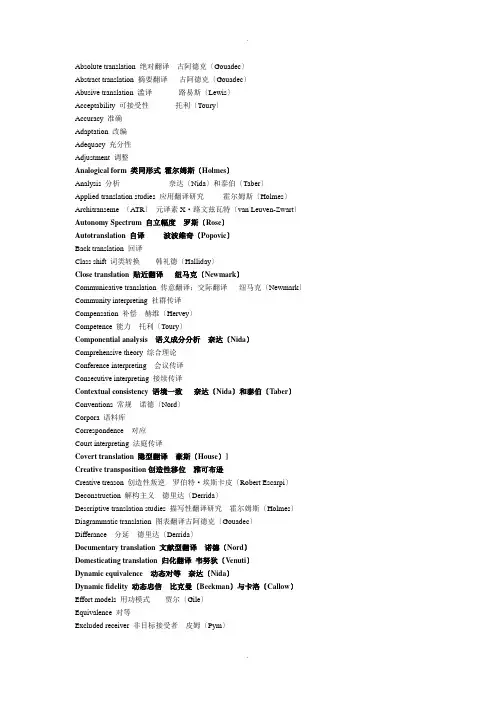
Absolute translation 绝对翻译古阿德克〔Gouadec〕Abstract translation 摘要翻译古阿德克〔Gouadec〕Abusive translation 滥译路易斯〔Lewis〕Acceptability 可接受性托利〔Toury〕Accuracy 准确Adaptation 改编Adequacy 充分性Adjustment 调整Analogical form 类同形式霍尔姆斯〔Holmes〕Analysis 分析奈达〔Nida〕和泰伯〔Taber〕Applied translation studies 应用翻译研究霍尔姆斯〔Holmes〕Architranseme 〔ATR〕元译素X·路文兹瓦特〔van Leuven-Zwart〕Autonomy Spectrum 自立幅度罗斯〔Rose〕Autotranslation 自译波波维奇〔Popovic〕Back translation 回译Class shift 词类转换韩礼德〔Halliday〕Close translation 贴近翻译纽马克〔Newmark〕Communicative translation 传意翻译;交际翻译纽马克〔Newmark〕Community interpreting 社群传译Compensation 补偿赫维〔Hervey〕Competence 能力托利〔Toury〕Componential analysis 语义成分分析奈达〔Nida〕Comprehensive theory 综合理论Conference interpreting 会议传译Consecutive interpreting 接续传译Contextual consistency 语境一致奈达〔Nida〕和泰伯〔Taber〕Conventions 常规诺德〔Nord〕Corpora 语料库Correspondence 对应Court interpreting 法庭传译Covert translation 隐型翻译豪斯〔House〕]Creative transposition创造性移位雅可布逊Creative treason 创造性叛逆罗伯特·埃斯卡皮〔Robert Escarpi〕Deconstruction 解构主义德里达〔Derrida〕Descriptive translation studies 描写性翻译研究霍尔姆斯〔Holmes〕Diagrammatic translation 图表翻译古阿德克〔Gouadec〕Differance 分延德里达〔Derrida〕Documentary translation 文献型翻译诺德〔Nord〕Domesticating translation 归化翻译韦努狄〔Venuti〕Dynamic equivalence 动态对等奈达〔Nida〕Dynamic fidelity 动态忠信比克曼〔Beekman〕与卡洛〔Callow〕Effort models 用功模式贾尔〔Gile〕Equivalence 对等Excluded receiver 非目标接受者皮姆〔Pym〕Exegetic translation 诠释性翻译赫维〔Hervey〕和希金斯〔Higgins〕Exoticism 异国情调赫维〔Hervey〕和希金斯〔Higgins〕Expectancy norms 期待规X 切斯特曼〔Chesterman〕Explicitation 明示维纳〔Vinay〕和达尔贝勒纳〔Darbelnet〕Expressive text 表情型文本赖斯〔Reiss〕Extraneous form 外来形式霍尔姆斯〔Holmes〕Faithfulness 忠实Foreignizing translation 异化翻译韦努狄〔Venuti〕Formal corresponding 形式对应卡特福德〔Catford〕Formal equivalence 形式对等奈达〔Nida〕Free translation [sense-for-sense translation 意对意翻译] {literal translation 字面翻译;word-for-word translation词对词翻译} 自由译Full translation 全文翻译General theories of translation 普通翻译理论霍尔姆斯〔Holmes〕Gist translation 要旨翻译赫维〔Hervey〕和希金斯〔Higgins〕Gloss translation 释词翻译奈达〔Nida〕Grammatical transposition 语法置换赫维〔Hervey〕和希金斯〔Higgins〕Hermeneutic motion 诠释步骤斯坦纳〔Steiner〕Hierarchy of Correspondences 对应层级霍尔姆斯〔Holmes〕Horizontal translation 横向翻译福勒纳〔Folena〕Hyperinformation 超额信息赖斯〔Reiss〕和弗米尔〔Vermeer〕Idiomatic translation 地道翻译比克曼〔Beekman〕与卡洛〔Callow〕Imitation 拟译 1.德莱顿〔Dryden〕2.利弗威尔〔Lefevere〕Indeterminacy 不确定性Information offer 信息提供弗米尔〔Vermeer〕Informative texts 信息文本赖斯〔Reiss〕Initial norms 初始规X 托利〔Toury〕Instrumental translation 工具翻译诺德〔Nord〕Integral translation 整合翻译X·路文兹瓦特〔van Leuven-Zwart〕Interlineal translation 隔行翻译{free translation} 赫维〔Hervey〕和希金斯〔Higgins〕Interlinear translation 逐行翻译Interlingual translation 语际翻译雅可布逊〔Jacobson〕Intersemiotic translation 符际翻译雅可布逊〔Jacobson〕Intralingual translation 语内翻译雅可布逊〔Jacobson〕Intra-system shift 系统内转换卡特福德〔Catford〕Inverse translation 逆向翻译Kernel sentence 核心句Keyword translation 关键词翻译古阿德克〔Gouadec〕Level shift 层次转换卡特福德〔Catford〕Lexical translation 词汇翻译卡特福德〔Catford〕Liaison interpreting[Bilateral interpreting 双边传译] 联络传译凯斯〔Keith〕Linguistic translation 语言翻译Literal translation 字面翻译;直译Mapping 图谱霍尔姆斯〔Holmes〕Matricial norms 矩阵规X 托利〔Toury〕Meta-language 元语言霍尔姆斯〔Holmes〕Metatext 元文本Mimetic form 模仿形式霍尔姆斯〔Holmes〕Mutation 变异X·路文兹瓦特〔van Leuven-Zwart〕Naturalness 自然性Negative shift 负面转换Norms 规XObligatory equivalents 必要对等语奈达〔Nida〕Oblique translation 曲径翻译维纳〔Vinay〕和达尔贝勒纳〔Darbelnet〕Operational model 操作模式巴斯盖特〔Bathgate〕Operational norms 操作规X 托利〔Toury〕Optional equivalents 可换对等语奈达〔Nida〕Overlapping translation 重合翻译赫维〔Hervey〕和希金斯〔Higgins〕Overt translation 显型翻译豪斯〔House〕Overtranslation 超额翻译维纳〔Vinay〕和达尔贝勒纳〔Darbelnet〕Paradigmatic equivalence X式对等波波维奇〔Popovic〕Paraphrase 释译德莱顿〔Dryden〕Partial theories of translation 局部翻译理论霍尔姆斯〔Holmes〕Participative receiver 参与型接受者皮姆〔Pym〕Particularizing translation 具体化翻译赫维〔Hervey〕和希金斯〔Higgins〕Performance 运用托利〔Toury〕Phonemic translation 音素翻译利弗威尔〔Lefevere〕Phonological translation 音位翻译卡特福德〔Catford〕Pivot language 中枢语言Polysystem theory 多元文化理论埃文·佐哈尔〔Even-Zohar〕Pragmatic translation[pragmatic approach语用途径] 语用翻译Preliminary norms 预先规X 托利〔Toury〕Prescriptive translation studies 规定翻译研究托利〔Toury〕Primary translation 首级翻译迪勒〔Diller〕和康纳留斯〔Kornelius〕Problem-restricted theories of translation 关于问题的翻译理论霍尔姆斯〔Holmes〕Process-oriented translation theories 过程取向翻译研究霍尔姆斯〔Holmes〕Product-oriented translation studies 成品取向翻译研究霍尔姆斯〔Holmes〕Professional norms 翻译规X 切斯特曼〔Chesterman〕Prospective translation 前瞻式翻译波斯特盖特〔Postgate〕Prototext 原型文本波波维奇〔Popovic〕Pseudotranslation 伪翻译Pure language[Logos 逻各斯] 纯语言沃尔特·本雅明〔Walter Benjamin〕Radical translation 原始翻译奎因〔Quine〕Rank-bound translation 级阶受限翻译卡特福德〔Catford〕Realia 独有特征弗拉科夫〔Vlakhov〕和弗罗林〔Florin〕Receptor language 接受语奈达〔Nida〕和泰伯〔Taber〕Translation with reconstruction 重构式翻译古阿德克〔Gouadec〕Redundancy 冗余奈达〔Nida〕Refraction 折射利弗威尔〔Lefevere〕Regulative translational conventions 规约性翻译常规诺德〔Nord〕Relay interpreting 转接传译Repertoreme 知识库要素托利〔Toury〕Resistancy 阻抗韦努狄〔Venuti〕Restricted translation 受限翻译卡特福德〔Catford〕Restructuring 重组奈达〔Nida〕和泰伯〔Taber〕Retrospective translation 后瞻式翻译波斯特盖特〔Postgate〕Rewriting 重写利弗威尔〔Lefevere〕Rhymed translation 韵体翻译利弗威尔〔Lefevere〕Secondary translation 二级翻译迪勒〔Diller〕和康纳留斯〔Kornelius〕Selective translation 选译古阿德克〔Gouadec〕Semantic disambiguation 语义消歧Semantic translation 语义翻译纽马克〔Newmark〕Serial translation 序列翻译卡塞格兰德〔Casagrande〕Service translation [Inverse translation 逆向翻译] 服务型翻译纽马克〔Newmark〕Sight translation 视译Signed language translation 手语传译Simultaneous interpreting 同声传译Skopos theory 目的论赖斯〔Reiss〕和弗米尔〔Vermeer〕Source language 源语Source text 源文本Source text-oriented translation studies 源文本取向翻译研究Specification 具体化Structure shift 结构转换卡特福德〔Catford〕Stylistic equivalence 文体对等Target language 目标语Term banks 术语库Terminology 术语Text typology 文本类型学Textual equivalence 文本对等卡特福德〔Catford〕Textual norms 文本规X 托利〔Toury〕Thick translation 增量翻译阿皮尔〔Appiah〕Think-aloud translation 有声思维记录Third code 第三语码弗劳利〔Frawley〕Time-restricted theories of translation 关于时域的翻译理论霍尔姆斯〔Holmes〕Total translation 完全翻译卡特福德〔Catford〕Transcription 注音Transeme 译素X·路文兹瓦特〔van Leuven-Zwart〕Transfer 转移Transference 迁移卡特福德〔Catford〕Translatability 可译性Translationese [Third language 第三语言] 翻译体Translatorial action 译者行动赫尔兹·曼塔里〔Holz Mänttäri〕Transliteration 音译Transposition 置换维纳〔Vinay〕和达尔贝勒纳〔Darbelnet〕Unbounded translation 不受限翻译卡特福德〔Catford〕Undertranslation 欠额翻译纽马克〔Newmark〕Unit of translation 翻译单位Universals of translation 翻译普遍特征Verbal consistency 词语一致Verifiability 可核实性赖斯〔Reiss〕和弗米尔〔Vermeer〕Vertical translation 纵向翻译福勒纳Voids 空缺Whispered interpreting 耳语传译Writer-oriented machine translation 作者取向机器翻译。
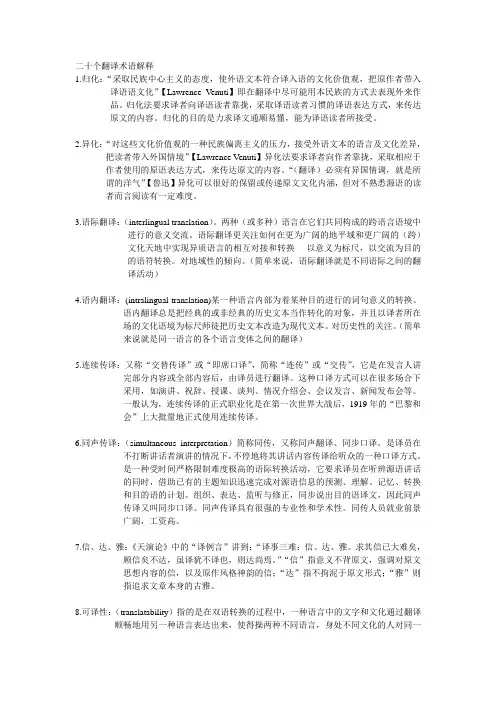
二十个翻译术语解释1.归化:“采取民族中心主义的态度,使外语文本符合译入语的文化价值观,把原作者带入译语语文化”【Lawrence V enuti】即在翻译中尽可能用本民族的方式去表现外来作品。
归化法要求译者向译语读者靠拢,采取译语读者习惯的译语表达方式,来传达原文的内容。
归化的目的是力求译文通顺易懂,能为译语读者所接受。
2.异化:“对这些文化价值观的一种民族偏离主义的压力,接受外语文本的语言及文化差异,把读者带入外国情境”【Lawrence V enuti】异化法要求译者向作者靠拢,采取相应于作者使用的原语表达方式,来传达原文的内容。
“(翻译)必须有异国情调,就是所谓的洋气”【鲁迅】异化可以很好的保留或传递原文文化内涵,但对不熟悉源语的读者而言阅读有一定难度。
3.语际翻译:(interlingual translation)。
两种(或多种)语言在它们共同构成的跨语言语境中进行的意义交流。
语际翻译更关注如何在更为广阔的地平域和更广阔的(跨)文化天地中实现异质语言的相互对接和转换----以意义为标尺,以交流为目的的语符转换。
对地域性的倾向。
(简单来说,语际翻译就是不同语际之间的翻译活动)4.语内翻译:(intralingual translation)某一种语言内部为着某种目的进行的词句意义的转换。
语内翻译总是把经典的或非经典的历史文本当作转化的对象,并且以译者所在场的文化语境为标尺师徒把历史文本改造为现代文本。
对历史性的关注。
(简单来说就是同一语言的各个语言变体之间的翻译)5.连续传译:又称“交替传译”或“即席口译”,简称“连传”或“交传”,它是在发言人讲完部分内容或全部内容后,由译员进行翻译。
这种口译方式可以在很多场合下采用,如演讲、祝辞、授课、谈判、情况介绍会、会议发言、新闻发布会等。
一般认为,连续传译的正式职业化是在第一次世界大战后,1919年的“巴黎和会”上大批量地正式使用连续传译。
6.同声传译:(simultaneous interpretation)简称同传,又称同声翻译、同步口译。
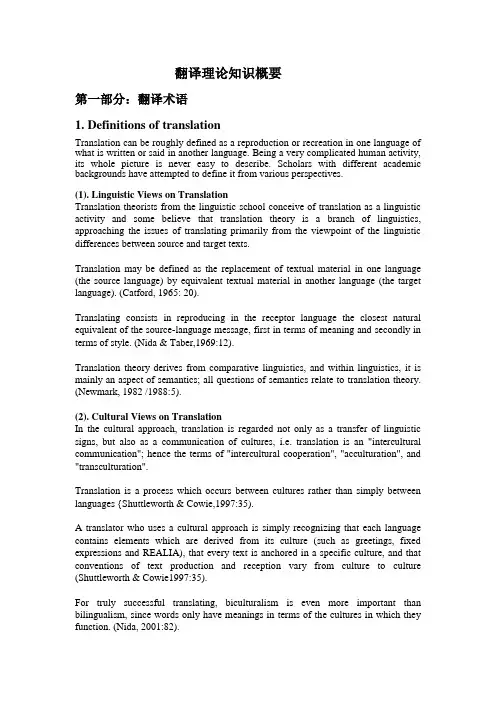
翻译理论知识概要第一部分:翻译术语1. Definitions of translationTranslation can be roughly defined as a reproduction or recreation in one language of what is written or said in another language. Being a very complicated human activity, its whole picture is never easy to describe. Scholars with different academic backgrounds have attempted to define it from various perspectives.(1). Linguistic Views on TranslationTranslation theorists from the linguistic school conceive of translation as a linguistic activity and some believe that translation theory is a branch of linguistics, approaching the issues of translating primarily from the viewpoint of the linguistic differences between source and target texts.Translation may be defined as the replacement of textual material in one language (the source language) by equivalent textual material in another language (the target language). (Catford, 1965: 20).Translating consists in reproducing in the receptor language the closest natural equivalent of the source-language message, first in terms of meaning and secondly in terms of style. (Nida & Taber,1969:12).Translation theory derives from comparative linguistics, and within linguistics, it is mainly an aspect of semantics; all questions of semantics relate to translation theory. (Newmark, 1982 /1988:5).(2). Cultural Views on TranslationIn the cultural approach, translation is regarded not only as a transfer of linguistic signs, but also as a communication of cultures, i.e. translation is an "intercultural communication"; hence the terms of "intercultural cooperation", "acculturation", and "transculturation".Translation is a process which occurs between cultures rather than simply between languages {Shuttleworth & Cowie,1997:35).A translator who uses a cultural approach is simply recognizing that each language contains elements which are derived from its culture (such as greetings, fixed expressions and REALIA), that every text is anchored in a specific culture, and that conventions of text production and reception vary from culture to culture (Shuttleworth & Cowie1997:35).For truly successful translating, biculturalism is even more important than bilingualism, since words only have meanings in terms of the cultures in which they function. (Nida, 2001:82).翻译不仅涉及语言问题,也涉及文化问题。
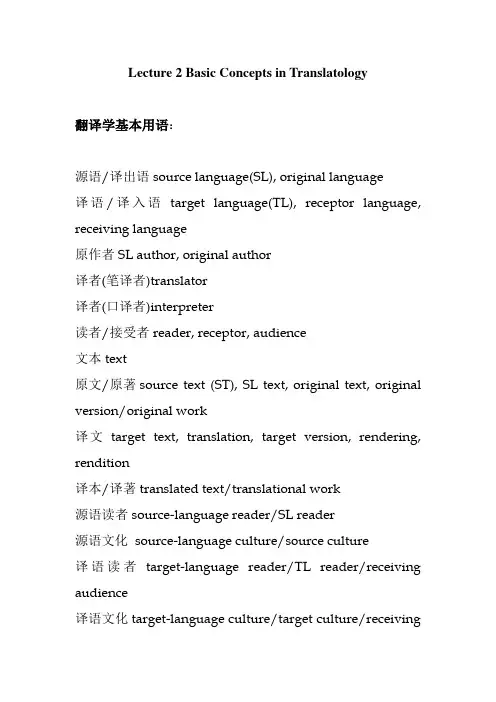
Lecture 2 Basic Concepts in Translatology翻译学基本用语:源语/译出语source language(SL), original language译语/译入语target language(TL), receptor language, receiving language原作者SL author, original author译者(笔译者)translator译者(口译者)interpreter读者/接受者reader, receptor, audience文本text原文/原著source text (ST), SL text, original text, original version/original work译文target text, translation, target version, rendering, rendition译本/译著translated text/translational work源语读者source-language reader/SL reader源语文化source-language culture/source culture译语读者target-language reader/TL reader/receiving audience译语文化target-language culture/target culture/receivingculture语境context笔译written translation口译oral interpretation/oral translation/interpreting同声传译simultaneous interpreting交替口译consecutive interpreting翻译原则translation principle标准translation criterion (复数形式为criteria)翻译过程translation process翻译程序/步骤translation procedures反应/读者反应response/reader’s response对应(部分对应/完全对应)(partial /full )correspondence等值/对等equivalence对等物(词语)equivalent形式对等formal equivalence功能对等functional equivalence动态对等dynamic equivalence等效equivalent effect充分性adequacy可接受性acceptability(acceptable, unacceptable, unacceptability)可读性readability(readable)可译性translatability(translatable)不可译性untranslatability(untranslatable)表层结构surface structure深层结构deep structure理解understanding/comprehension表达expression再现reproduction/representation转换transformation传译/转移transferral/transfer误解misunderstanding误译mis-translation异化foreignization/alienation/exoticization/ exogenization/source-oriented translation归化domestication/naturalization/adaptation/endogenization /target-accommodating translation词汇空缺lexical gap文化沟(空缺/非对应)cultural gap直译literal translation/direct translation意译free translation/liberal translation/semantic translation直译派a literalist/a sourcerer意译派a free-hander/a targeteer重复法repetition增译法/增词法/增译amplification/addition 减译法/减词法/省略法/省译omission词类转移法/词性转换conversion反译法/正反译法/反正译法negation移植法transplant(ing)/transplantation音译法transliteration具体化specification概括化generalization抽象化abstracting明析化explicitation译借(语义转借)calque(loan translation)加注法annotation夹注intratextual note脚注footnote尾注/文后注endnote注释性翻译annotated/commented translation 释义法/解释法explanation/paraphrase引申法extension替代法substitution/replacement借用borrowing推演法deduction缀合法combination分译法division逆序法/倒置法reversing合译法combination综合法mixture of methods包孕embedding切断/分切cutting拆离splitting-off插入inserting重组recasting回译back translation还原法finding out the original原汁原味essence of the original, original flavor 词序调整inversion选词diction补偿compensation视点转换shift of perspective套译/仿译/仿拟imitation信/忠实faithfulness/fidelity达/易懂intelligibility/expressiveness通顺smoothness流畅fluency自然naturalness /idiomaticity雅/优美elegance/gracefulness简洁brevity明析clarity简明conciseness内涵connotation含义implication言外之意allocution本文意义(文本固有之意)inherent meaning (of the text)译者隐形translator’s invisibility透明(度)transparency宁信而不顺(鲁迅语) rahter to be faithful than smooth (“I’d rather be faithful than smooth”)神似(傅雷语) spiritual resemblance化境(钱钟书语)sublimation信、达、切(刘重德语)faithfulness, expressiveness and closeness (to the original style)三美: 音美,形美,意美(许渊冲语)the three beauties: beauty in sound, beauty in form and beauty in meaning东方语言Oriental languages西方语言Occidental languages佛经Buddhist Scriptures/sutra梵语Sanskrit鸠摩罗什Kumarajiva泰特勒(Alexander Fraser )Tytler奈达(Eugene A.) Nida机器翻译machine translation(MT)人工智能artificial intelligence(AI)翻译translate, render, rephrase, reword, transmit, re-express, transmute, transmogrify, interpret, convert, transform, transpose, express, transfer, turn 翻译学translatology/Translation Studies翻译体/翻译腔translationese死译/硬译mechanical translation逐字译word-for-word translation/word-to-word substitution/verbatim translation乱译/胡译excessively free translation歪译(意义扭曲)distortion惯用法usage搭配collocation约定俗成convention形合hypotaxis意合parataxis对应:(Correspondence)1)full correspondence:e.g. chalk2)partial correspondence e.g. 山(hill/mountain),虾(shrimp/lobster)青(blue/green/black)morning (早晨/上午)3)non- correspondence e.g. 粽子zongzi (a traditional food which eaten on Dragon Boat Festival in China ) / a pyramid-shaped rice dumpling wrapped inreed leafMagistrate 治安法官, 地方行政官Salad 色拉Examples:我的眼睛没有错,他是个小男孩。
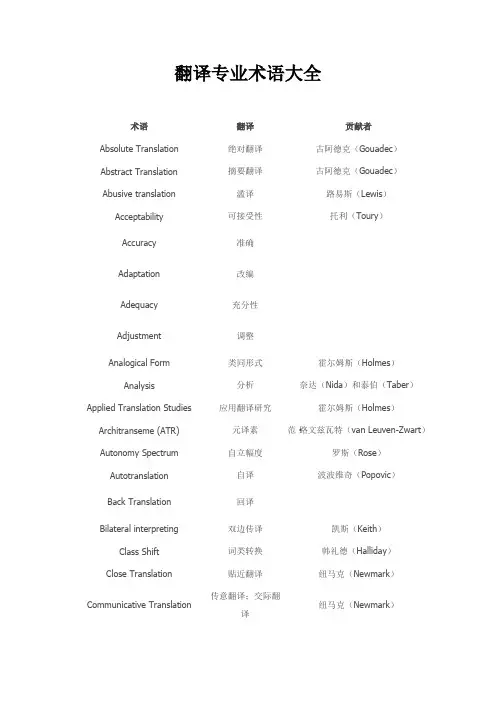
翻译专业术语大全术语翻译贡献者Absolute Translation绝对翻译古阿德克(Gouadec)Abstract Translation摘要翻译古阿德克(Gouadec)Abusive translation滥译路易斯(Lewis)Acceptability可接受性托利(Toury)Accuracy准确Adaptation改编Adequacy充分性Adjustment调整Analogical Form类同形式霍尔姆斯(Holmes)Analysis分析奈达(Nida)和泰伯(Taber)Applied Translation Studies应用翻译研究霍尔姆斯(Holmes)Architranseme (ATR)元译素范·路文兹瓦特(van Leuven-Zwart)Autonomy Spectrum自立幅度罗斯(Rose)Autotranslation自译波波维奇(Popovic)Back Translation回译Bilateral interpreting双边传译凯斯(Keith)Class Shift词类转换韩礼德(Halliday)Close Translation贴近翻译纽马克(Newmark)Communicative Translation 传意翻译;交际翻译纽马克(Newmark)Community interpreting社群传译Compensation补偿赫维(Hervey)Competence能力托利(Toury)Componential Analysis语义成分分析奈达(Nida)Comprehensive theory综合理论Conference interpreting会议传译Consecutive interpreting接续传译Contextual consistency语境一致奈达(Nida)和泰伯(Taber)Conventions常规诺德(Nord)Corpora语料库Correspondence对应Court interpreting法庭传译Covert translation隐型翻译豪斯(House)Creative transposition创造性转换Creative treason创造性叛逆罗伯特·埃斯卡皮(Robert Escarpi)Deconstruction解构主义德里达(Derrida)Descriptive translation studies描写性翻译研究霍尔姆斯(Holmes)Differance分延德里达(Derrida)Doentary translation文献型翻译诺德(Nord)Domesticating translation归化翻译韦努狄(Venuti)Dynamic equivalence动态对等奈达(Nida)Dynamic fidelity动态忠信比克曼(Beekman)和卡洛(Callow)Effort models用功模式贾尔(Gile)Excluded receiver非目标接受者皮姆(Pym)Exegetic translation诠释性翻译赫维(Hervey)和希金斯(Higgins)Exoticism异国情调赫维(Hervey)和希金斯(Higgins)Expectancy norms期待规范切斯特曼(Chesterman)Explicitation明示维纳(Vinay)和达尔贝勒纳(Darbelnet)Expressive text表情型文本赖斯(Reiss)Extraneous form外来形式霍尔姆斯(Holmes)Faithfulness忠实Foreignizing translation异化翻译韦努狄(Venuti)Formal corresponding形式对应卡特福德(Catford)Formal equivalence形式对等奈达(Nida)Free translation自由译Full translation全文翻译General theories of translation普通翻译理论霍尔姆斯(Holmes)Gist translation要旨翻译赫维(Hervey)和希金斯(Higgins)Gloss translation释词翻译奈达(Nida)Grammatical transposition语法置换赫维(Hervey)和希金斯(Higgins)Hermeneutic motion诠释步骤斯坦纳(Steiner)Hierarchy of Correspondences对应层级霍尔姆斯(Holmes)Horizontal translation横向翻译福勒纳(Folena)Hyperinformation超额信息赖斯(Reiss)和弗米尔(Vermeer)Idiomatic translation地道翻译比克曼(Beekman)和卡洛(Callow)Imitation拟译德莱顿(Dryden)、利弗威尔(Lefevere)Indeterminacy不确定性Information offer信息提供弗米尔(Vermeer)Informative texts信息文本赖斯(Reiss)Initial norms初始规范托利(Toury)Instrumental translation工具翻译诺德(Nord)Integral translation整合翻译范·路文兹瓦特(van Leuven-Zwart)Interlineal translation隔行翻译赫维(Hervey)和希金斯(Higgins)Interlinear translation逐行翻译Interlingual translation语际翻译雅可布逊(Jacobson)Intersemiotic translation符际翻译雅可布逊(Jacobson)Intralingual translation语内翻译雅可布逊(Jacobson)Intra-system shift系统内转换卡特福德(Catford)Inverse translation逆向翻译Kernel sentence核心句Keyword translation关键词翻译古阿德克(Gouadec)Level shift层次转换卡特福德(Catford)Lexical translation词汇翻译卡特福德(Catford)Liaison interpreting联络传译凯斯(Keith)Linguistic translation语言翻译Literal translation字面翻译;直译Mapping图谱霍尔姆斯(Holmes)Matricial norms矩阵规范托利(Toury)Meta-language元语言霍尔姆斯(Holmes)Metatext元文本Mimetic form模仿形式霍尔姆斯(Holmes)Mutation变异范·路文兹瓦特(van Leuven-Zwart)Naturalness自然性Negative shift负面转换Norms规范Obligatory equivalents必要对等语奈达(Nida)Oblique translation曲径翻译维纳(Vinay)和达尔贝勒纳(Darbelnet)Operational model操作模式巴斯盖特(Bathgate)Operational norms操作规范托利(Toury)Optional equivalents可换对等语奈达(Nida)Overlapping translation重合翻译赫维(Hervey)和希金斯(Higgins)Overt translation显型翻译豪斯(House)Overtranslation超额翻译维纳(Vinay)和达尔贝勒纳(Darbelnet)Paradigmatic equivalence范式对等波波维奇(Popovic)Paraphrase释译德莱顿(Dryden)Partial theories of translation局部翻译理论霍尔姆斯(Holmes)Participative receiver参与型接受者皮姆(Pym)Particularizing translation具体化翻译赫维(Hervey)和希金斯(Higgins)Performance运用托利(Toury)Phonemic translation音素翻译利弗威尔(Lefevere)Phonological translation音位翻译卡特福德(Catford)Pivot language中枢语言Polysystem theory多元文化理论埃文·佐哈尔(Even-Zohar)Pragmatic Approach语用途径Pragmatic translation语用翻译Preliminary norms预先规范托利(Toury)Prescriptive translation studies规定翻译研究托利(Toury)Primary translation首级翻译迪勒(Diller)和康纳留斯(Kornelius)Problem-restricted theories oftranslation 关于问题的翻译理论霍尔姆斯(Holmes)Process-oriented translationtheories过程取向翻译研究霍尔姆斯(Holmes)Product-oriented translationstudies成品取向翻译研究霍尔姆斯(Holmes)Professional norms翻译规范切斯特曼(Chesterman)Prospective translation前瞻式翻译波斯特盖特(Postgate)Prototext原型文本波波维奇(Popovic)Pseudotranslation伪翻译Pure language纯语言沃尔特·本雅明(Walter Benjamin)Radical translation原始翻译奎因(Quine)Rank-bound translation级阶受限翻译卡特福德(Catford)Realia独有特征弗拉科夫(Vlakhov)和弗罗林(Florin)Receptor language接受语奈达(Nida)和泰伯(Taber)Translation with reconstruction重构式翻译古阿德克(Gouadec)Redundancy冗余奈达(Nida)Refraction折射利弗威尔(Lefevere)Regulative translational规约性翻译常规诺德(Nord)conventionsRelay interpreting转接传译Repertoreme知识库要素托利(Toury)Resistancy阻抗韦努狄(Venuti)Restricted translation受限翻译卡特福德(Catford)Restructuring重组奈达(Nida)和泰伯(Taber)Retrospective translation后瞻式翻译波斯特盖特(Postgate)Rewriting重写利弗威尔(Lefevere)Rhymed translation韵体翻译利弗威尔(Lefevere)Secondary translation二级翻译迪勒(Diller)和康纳留斯(Kornelius)Selective translation选译古阿德克(Gouadec)Semantic disambiguation语义消歧Semantic translation语义翻译纽马克(Newmark)Serial translation序列翻译卡塞格兰德(Casagrande)Service translation服务型翻译纽马克(Newmark)Signed language translation手语传译Simultaneous interpreting同声传译Skopos theory目的论赖斯(Reiss)和弗米尔(Vermeer)Source language源语Source text-oriented translationstudies 源文本取向翻译研究Specification具体化Structure shift结构转换卡特福德(Catford)Stylistic equivalence文体对等Term banks术语库Terminology术语Text typology文本类型学Textual equivalence文本对等卡特福德(Catford)Textual norms文本规范托利(Toury)Thick translation增量翻译阿皮尔(Appiah)Third code第三语码弗劳利(Frawley)Time-restricted theories oftranslation 关于时域的翻译理论霍尔姆斯(Holmes)Total translation完全翻译卡特福德(Catford)Transcription注音Transeme译素范·路文兹瓦特(van Leuven-Zwart)Transfer转移Transference迁移卡特福德(Catford)Translatability可译性Translationese翻译体Translatorial action译者行为赫尔兹·曼塔里(Justa Holz-Manttari)Transliteration音译维纳(Vinay)和达尔贝勒纳Transposition置换(Darbelnet)Unbounded translation不受限翻译卡特福德(Catford)Undertranslation欠额翻译纽马克(Newmark)Unit of translation翻译单位Universals of translation翻译普遍特征Verbal consistency词语一致Verifiability可核实性赖斯(Reiss)和弗米尔(Vermeer)。
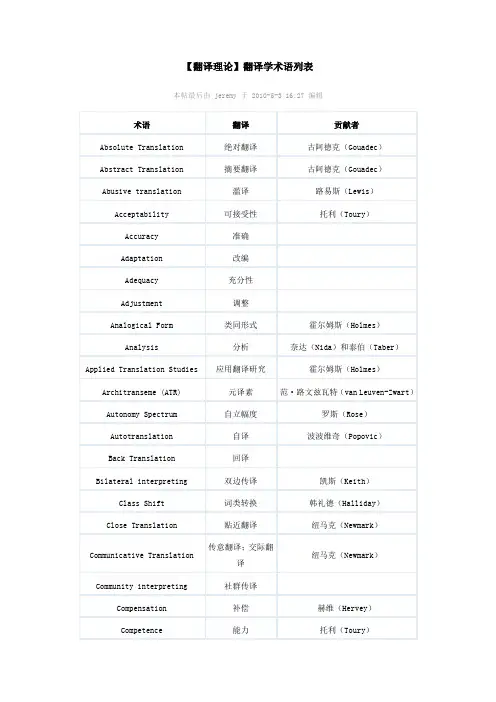
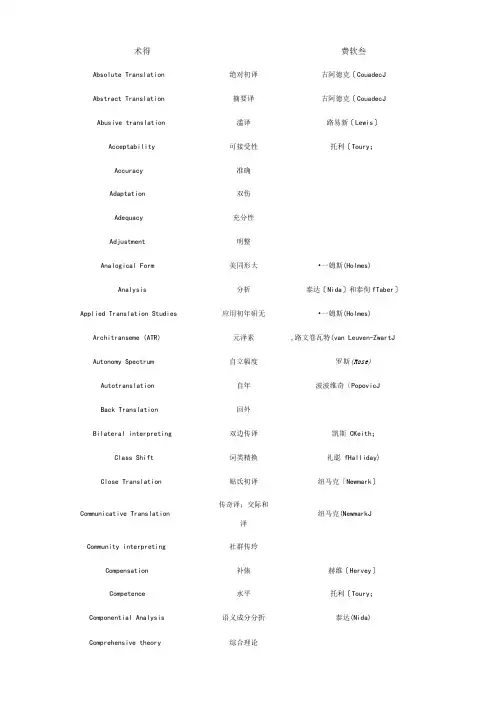
术得费软叁Absolute Translation 绝对初译古阿德克〔CouadecJ Abstract Translation 摘要译古阿德克〔CouadecJ Abusive translation 滥译路易新〔Lewis〕Acceptability 可接受性托利〔Toury;Accuracy 准确Adaptation 双伤Adequacy 充分性Adjustment 明整Analogical Form 美同形大•一姆斯(Holmes) Analysis 分析泰达〔Nida〕和泰佝fTaber〕Applied Translation Studies 应用初年研无•一姆斯(Holmes) Architranseme (ATR) 元泽素,路文卷瓦特(van Leuven-ZwartJ Autonomy Spectrum 自立幅度罗斯(Rose) Autotranslation 自年波波维奇〔PopovicJBack Translation 回外Bilateral interpreting 双边传译凯斯CKeith;Class Shift 词类精换礼聪fHalliday) Close Translation 贴氏初译纽马克「Newmark〕传奇译;交际和Communicative Translation纽马克(NewmarkJ泽Community interpreting 社群传玲Compensation 补俵赫维〔Hervey〕Competence 水平托利〔Toury;Componential Analysis 语义成分分折泰达(Nida)Comprehensive theory 综合理论Conference interpreting 会议传译Consecutive interpreting 接续传译Contextual consistency 语地一改泰达〔Nida〕和泰佝fTaber〕Conventions *规诺德〔Nord〕Corpora 语料库Correspondence 对应Court interpreting 法庭传译Covert translation 晦型译豪斯fHouse) Creative transposition 创选性转换Creative treason 创选性叛逆罗的精•埃斯卡皮〔Robert EscarpiJ Deconstruction 解构主义掠里达(Derrida)Descriptive translation studies 楮写性译研•比•一姆斯(Holmes) Diagrammatic translation 图表译古阿提克〔Couadec〕Differance 分延掠里达(Derrida) Doentary translation 文故更翻泽诺堤〔Nord〕Domesticating translation 归化译韦努狄(VenutiJ Dynamic equivalence 动杰对等鑫达(Nida)Dynamic fidelity 动杰忠信比克曼CBeekmanJ和卡洛〔Callow〕Effort models 用功模为要乐CGileJEquivalence 对等Excluded receiver 非n标接•交者皮姆(Pym)Exegetic translation 诠释性翻泽尚维fHerveyJ和希金斯fHigginsJ Exoticism 异国情*q 椅维fHerveyJ和希金斯fHigginsJ Expectancy norms 期待规切斯材受fChesterman) Explicitation 明示维纳fVinay〕和达尔贝勒纳〔DarbelnetjExpressive textExtraneous formFaithfulnessForeignizing translationFormal correspondingFormal equivalenceFree translationFull translation General theories of translation Gist translationGloss translationGrammatical transpositionHermeneutic motion Hierarchy of Correspondences Horizontal translationHyperinformationIdiomatic translationImitationIndeterminacyInformation offerInformative textsInitial normsInstrumental translationIntegral translationInterlineal translationInterlinear translation表情型文本忠实异化初年自由泽金文译普通初年理论要a译绛的译诠粹步骤对应层级横向译姆领信息地道译拟降不确定性信息提供信息文本初始规工具译整合译周行译遂行译赖斯(Reiss)农泰林斯〔Holmes〕韦努秋(VenutiJ卡耐福思〔Catford〕奈达〔Nida;笈余姆斯〔Holmesj尚维fHerveyJ和希金斯fHigginsJ奈达〔Nida;尚维fHerveyJ和希金斯fHigginsJ斯坦纳〔Steiner〕笈余姆斯〔Holmesj福勒纳CFolena)赖斯〔Reiss〕和希米尔〔Vermeer〕比克曼〔BeekmanJ和卡洛〔Callow〕掠莱顿〔Dryden人利希龙乐r Lefevere〕布米尔(VermeerJ赖斯(Reiss)托利(TouryJ诺堤〔Nord〕,路文卷瓦特(van Leuven-ZwartJ据维〔Hervey;和希金斯〔Higgins〕Interlingual translation 语际初译雅可布逊〔JacobsonJ Intersemiotic translation 符际初译雅可布逊〔JacobsonJ Intralingual translation 雅可布逊〔JacobsonJ Intra-system shift 条统转换卡林福建〔CatfordJ Inverse translation 走向译Kernel sentence 枝心勺Keyword translation 关健词翻泽古阿提克〔Couadec〕Level shift 层次精换卡特福瘪〔CatfordJ Lexical translation 词汇译卡特福瘪〔CatfordJ Liaison interpreting 麻络传译凯斯CKeith;Linguistic translation 语言译Literal translation 字而初泽;玄泽Mapping 图诺•一姆斯(Holmes) Matricial norms 矩阵规托利(TouryJMeta-language 元语言•一姆斯(Holmes) Metatext 元文本Mimetic form 模仿形大•一姆斯(Holmes) Mutation 变异,路文卷瓦特(van Leuven-ZwartJ Naturalness 自然性Negative shift 负面精换Norms 规Obligatory equivalents 必要对等语鑫达(Nida)维纳fVinayJ和达尔贝勒纳Oblique translation 曲及译〔Darbelnetj Operational model 燎作模式巴斯盖柠fBathgate〕Operational norms 掾作规托利(TouryJOptional equivalents 可换对等语泰达〔Nida;Overlapping translation 重合初年尚维fHerveyJ和希金斯(Higginsj Overt translation 星型初译豪斯〔House;Overtranslation 超额初译维纳fVinayJ和达余贝勒纳〔Darbelnetj Paradigmatic equivalence 太对等波波维奇CPopovicJ Paraphrase 村年掠茶顿(Dryden)Partial theories of translation 局部初译理论看泰姆斯〔HolmesJ Participative receiver 参与型接受者皮姆(Pym) Particularizing translation 其体化译恭维〔Hervey;和希金斯〔Higgins〕Performance 运用托利〔Toury;Phonemic translation 音素初年矛」希贰尔〔Lefevere〕Phonological translation 音伍初年卡甘福建〔CatfordJ Pivot language 中枢语言Polysystem theory 多元文化理论埃文•佐哈尔〔Even-ZoharjPragmatic Approach 语用途及Pragmatic translation 语用初年Preliminary norms 预先规托利〔Toury;Prescriptive translation studies 规定译研究托利〔Toury;Primary translation 首级初年迪勒〔Diller〕和康纳智斯fKorneliusJProblem-restricted theories oftranslation 关于问题的和年理论看泰姆斯〔HolmesJProcess-oriented translationtheories11程取向译研究府余姆斯〔HolmesJ Product-oriented translationstudies成g取向初年研究笈尔垓斯〔Holmes〕Professional norms 初泽规切斯柠史(Chesterman)Prospective translation 看赡尤翻泽波斯杵盖特CPostgateJ Prototext 原型文本波波维奇(PopovicJ Pseudotranslation 伪初泽Pure language 的语言沃余柠,本雅明^Walter Benjamin) Radical translation 原如译奎因(QuineJ Rank-bound translation 级阶受限匐译卡特福瘪(CatfordJ Realia 独有将征布拉科夫(Vlakhov)和第罗林(Florin) Receptor language 接受语泰达(Nida)和泰佝fTaber) Translation with reconstruction 重妁太翻泽古阿提克(Couadec) Redundancy 五余鑫达(Nida)Refraction 折对利布成余(Lefevere ) Regulative translational conventions 规约性初泽常规诺博(Nord) Relay interpreting 转接传书Repertoreme 知盟库要素托利(Toury;Resistancy 抗韦努狄fVenutiJ Restricted translation •更限初年卡甘福建(CatfordJ Restructuring 重姐泰达(Nida)和泰佝fTaber) Retrospective translation 后唔尤初泽波斯将盖特(Postgatej Rewriting 重写矛」希贰尔(Lefevere) Rhymed translation 韵体初年矛」希贰尔(Lefevere) Secondary translation 二级初年迪勒(Diller)和康纳智斯fKorneliusJ Selective translation 选外古阿徒克(Couadec) Semantic disambiguation 语义清故Semantic translation 语义初年纽马克(Newmark) Serial translation 序列初年卡塞格.言德(CasagrandeJService translation 效劳型翻泽纽马克〔NewmarkJSight translation 视译Signed language translation 手语传译Simultaneous interpreting 同声传译Skopos theory 〔\的论赖斯〔Reiss〕为希米尔〔Vermeer〕Source language 源语Source text 源文本Source text-oriented translationstudies 源文本取的译研无Specification 具体化Structure shift 结构转换卡甘福建〔CatfordJ Stylistic equivalence 文体对等Target languageTerm banks 术语库Terminology 术语Text typology 文本类型学Textual equivalence 文本对等卡甘福建〔CatfordJ Textual norms 文本现托利〔TouryJThick translation 增量初年阿史泰〔AppiahJThink-aloud translation 有力思维记录Third code 第三语吗弗劳利〔Frawley〕Time-restricted theories oftranslation关于时城的和年理论农泰姆斯〔HolmesJ Total translation 免全初年卡莉福鹿、〔CatfordJTranscription 注音Transeme 译素•路文卷瓦特〔van Leuven-ZwartJTransfer 转移Transference 迁移卡林福建(CatfordJTranslatability 可泽性Translationese 初泽体Translatorial action 译者行为尚东旌・曼沐里〔Justa Holz-ManttariJ Transliteration 音译Transposition 笈挨维纳fVinayJ和达尔贝勒纳(Darbelnetj Unbounded translation 不受限初泽卡甘福建(CatfordJ Undertranslation 欠领加译纽马克〔NewmarkJUn什of translation 译单位Universals of translation 匐年普遍籽征Verbal consistency 词语一致Verifiability 可核实性赖新(Reiss)和希米余(Vermeer) Vertical translation 纵向初年施勒纳Voids 全然Whispered interpreting 耳语传玲。
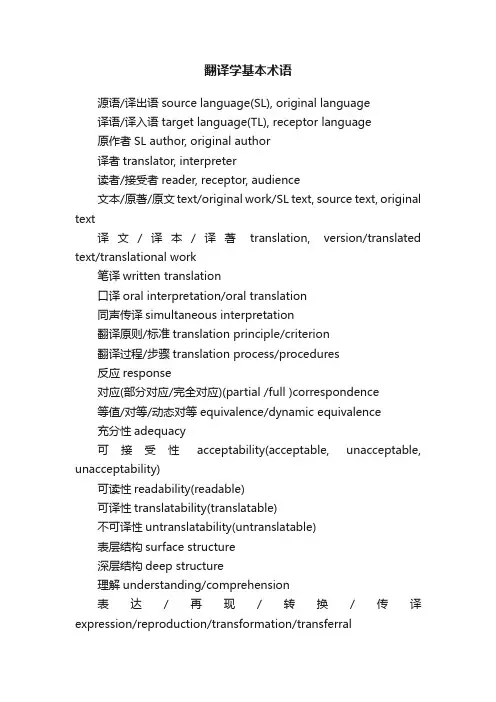
翻译学基本术语源语/译出语source language(SL), original language译语/译入语target language(TL), receptor language原作者SL author, original author译者translator, interpreter读者/接受者reader, receptor, audience文本/原著/原文text/original work/SL text, source text, original text译文/译本/译著translation, version/translated text/translational work笔译written translation口译oral interpretation/oral translation同声传译simultaneous interpretation翻译原则/标准translation principle/criterion翻译过程/步骤translation process/procedures反应response对应(部分对应/完全对应)(partial /full )correspondence等值/对等/动态对等equivalence/dynamic equivalence充分性adequacy可接受性acceptability(acceptable, unacceptable, unacceptability)可读性readability(readable)可译性translatability(translatable)不可译性untranslatability(untranslatable)表层结构surface structure深层结构deep structure理解understanding/comprehension表达/再现/转换/传译expression/reproduction/transformation/transferral误解misunderstanding误译mis-translation异化foreignization/alienation归化domestication/naturalization/adaptation直译literal translation意译free translation/liberal translation/semantic translation 直译派a literalist/a sourcerer意译派a free-hander/a targeteer重译法repetition增译法/增词法/增译amplification/addition减译法/减词法/省译omission词类转移法/词性转换conversion反译法negation移植法transplant(ing)音译法transliteration作注(行内注/脚注/文后注)annotation(interlinear note, footnote, endnote)释义法/解释法explanation/paraphrase 引申法extension替代法substitution 推演法deduction 缀合法combination分译法division 逆序法/倒置法reversing 合译法combination 综合法mixture of methods 包孕embedding 切断/分切cutting 拆离splitting-off 插入inserting 重组recasting回译back translation 原汁原味essence of the original词序调整inversion选词diction信/忠实faithfulness/fidelity达/通顺/流畅/自然/易懂intelligibility /smoothness /fluency /naturalness /idiomaticity /expressiveness雅elegance/gracefulness 东方语言Oriental languages西方语言Occidental languages 佛经Buddhist Scriptures/sutra 梵语Sanskrit 鸠摩罗什Kumarajiva 泰特勒(AlexanderFraser )Tytler奈达Eugene A. Nida 机器翻译machine translation(MT)人工智能artificial intelligence(AI)翻译translate, render, rephrase, reword, transmit, re-express, transmute, transmogrify, interpret, convert, transform, transpose, express, transfer, turn翻译学translatology/translation studies 翻译体/翻译腔translationese死译/硬译/逐字译mechanical translation/word-for-word translation/word-to-word substitution乱译/胡译excessively free translation 惯用法usage约定俗成convention形合hypotaxis 意合parataxis。
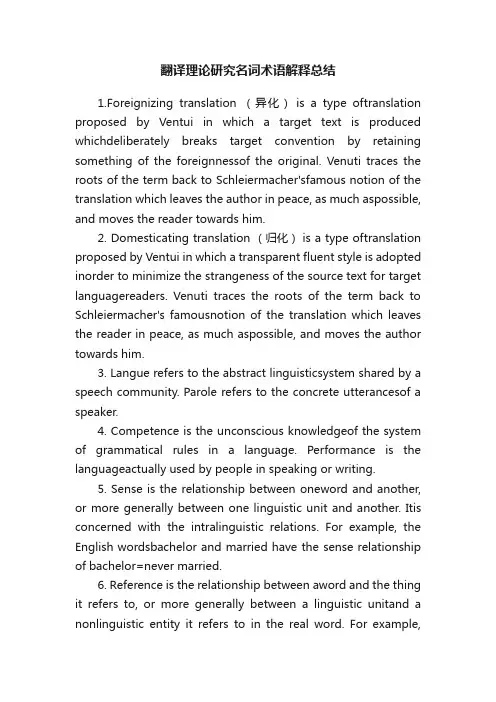
翻译理论研究名词术语解释总结1.Foreignizing translation (异化) is a type oftranslation proposed by Ventui in which a target text is produced whichdeliberately breaks target convention by retaining something of the foreignnessof the original. Venuti traces the roots of the term back to Schleiermacher'sfamous notion of the translation which leaves the author in peace, as much aspossible, and moves the reader towards him.2. Domesticating translation (归化) is a type oftranslation proposed by Ventui in which a transparent fluent style is adopted inorder to minimize the strangeness of the source text for target languagereaders. Venuti traces the roots of the term back to Schleiermacher's famousnotion of the translation which leaves the reader in peace, as much aspossible, and moves the author towards him.3. Langue refers to the abstract linguisticsystem shared by a speech community. Parole refers to the concrete utterancesof a speaker.4. Competence is the unconscious knowledgeof the system of grammatical rules in a language. Performance is the languageactually used by people in speaking or writing.5. Sense is the relationship between oneword and another, or more generally between one linguistic unit and another. Itis concerned with the intralinguistic relations. For example, the English wordsbachelor and married have the sense relationship of bachelor=never married.6. Reference is the relationship between aword and the thing it refers to, or more generally between a linguistic unitand a nonlinguistic entity it refers to in the real word. For example,therelationship between the word tree and the objet tree in the real world.7. Phonetics is a branch of linguisticswhich refers to the study of speech sounds, especially of their production,transmission, and reception. It is the general study of the characteristics ofspeech sounds.8. Phonology is a branch of linguisticswhich refers to the study of the systems and patterns of speech sounds in alanguage. It aims to discover the principles that govern the way sounds areorganized in languages, and also toexplain the variations that occur. Phonetics is the study of speech sounds thathuman voice is capable of creating. Phonology is the study of a subset of thosesounds that constitute language and meaning. The former focuses on chaos whilethe latter focuses on order. Therefore these two are at once related anddistinct branches of linguistics.9.Inflectional morphology studies the wayin which words vary in order to express grammatical contrasts insentences, such as single/plural, past tense/present tense, bark+s=barks.10. Derivational morphology studies theprinciples governing the construction of new words, without reference to thegrammatical role a word might play in a sentence.11. Informative function: language is usedto tell something, to give information, or to reason something out. Forexample, the function of the sentece Wwater boils at 100 degree centigrade isinformative.12. Interpersonal function: language isused to establish and maintain social relations between people. For example,the way in which people address others and refer to themselves, such as'dear sir, your obedient servant, indicate the various grades ofinterpersonal relations.13. Performative function: language is usedto do things or to perform acts. For example, at a meeting, as soon as thechairman says I declare the meeting open, the meeting has started.14. Phatic function: language is used toestablish an atmosphere or maintain social contact between the speaker andhearer. For example, the expression such as how do you do does not conveyanymeaning, but are used to establish a common sentiment between the speakerand hearer.15. Emotive function: language is used toexpress the speaker's attitudes and feelings. For example, my god!16. Recreational function: language is usedfor te sheer joy. For example, a chanting.17. Conceptual meaning is the basicessential components of meaning which is conveyed by the lteral use of a word.For example, the basic concepts of a word like needle in english might includethin sharp, steel, instrument, which would be part of the conceptual meaning ofthe word needle.18. Associative meaning is te total of allthe meanings a person thinks of when he hear the word. For example, you mayhave associations attached to a word like needle which lead you to think ofpainful whenever you encounter the word.19. Constituent command refers to therelation between an element and another of the same level and under the samenode in a tree diagram, and any others under the latter element as well. Forexample, in the prepositional phrase in the book, the preposition inconstituent command the following noun phrase the book, and the constituentcommand book not in.20. Speech variety refers to anydistinguishable form of a language used by a speaker or a group of speakers. Itis considered a more neutral term than the terms such as standardlanguage anddialect.21. The behaviorist view of languageacquisition: language acqusition is a process of habit formation. Language islearned through stimulus and reinforcement. Reinforcement of selected responsesis the key to understand language development. Children learn to producecorrect sentences because they are positively reinforced when they saysomething right and negatively reinforced when they say something wrong.22. The nativist view of languageacquisition: language acqusition is a specific property of human beings.Children are born with an innate ability to acquire language. They arepredisposed to develop their native language along a universal predeterminedroute through similar stages. They go about acquiring the grammar of theirnative language using principles unique to language acquisition.23. Euphemism refers to the use of a wordwhich is thought to be less offensive or unpleasant than another word. Forexample, indisposed instead of sick, or pass away instead of die.24. Taboo refers to a word or expressionthat is prohibited by the polite society from general use. For example, cunt,prick, fuck, for vagina, penis, sexual intercourse.25.Lingua franca refers to a language thatis used for communication between different groups of people, each speaking adifferent language. For example, english is an international lingua franca usedin numerous social and political situations where a common language is asked for.26. Variationist linguistics refers to atheoretic framework advanced by william labov to study how language variationand change take place in different social contexts or geographic districtsunder the influence of social factors such aseconomics,education, class,gender, style, and so on. The method it uses is basically quantitative, butqualitative instruments have recently been introduced in this branch oflinguistic research fora better description and explanation of the datacollected.27. Critical period is a period in oneslife extending from about age two to puberty, during which the human brain ismost ready to acquire a particular language naturally and effortlessly. It is aperiod that coincides with the period of brain lateralization for languagefunctions.28. Critical period hypothesis is thetheory which states that in child development there is a period in ones lifeextending from about age two to puberty, during which the human brain is most readyto acquire a particular language naturally and effortlessly. There are twoversions of the critical period hypothesis. While the strong one suggests thatchildren must acquire their first language by puberty or they will never beable to learn from subsequent exposure, the weak holds that language learningwill be more different and incomplete after puberty. These two views can findsome support respectively in victors and genies cases.29. Translationese refers to targetlanguage usage which because of its obvious reliance on features of sourcelanguage is perceived as unnatural, impenetrable, or even comical. It istypically caused by an excessively literal approach to the translation processor an imperfect knowledge of target language, and is reflected in theperception that the source language of a translation seems reluctant to makeits exit, and it prefers to seek reincarnation in the target language.30. Interlanguageis the type of language produced by foreign or second language learners who arein the process of learning a language. It is the approximate language systemthat asecond language learner constructs which represents his or hertransitional competence in the target language.31. Over translation is the translationthat gives more detail than the original.32. Under translation is the translationthat gives less detail and is more general than the original.33. Transcription is a type of interlingualtransfer in which the forms of the original are preserved unchanaged in targettext.34. Transliteration is a process in whichsource language graphological units are replaced by target languagegraphological units.35. Source culture-linked overttranslation: semantic translation36. Source culture-linked coverttranslation: communicative translation37. Back translation is a process in whicha text which has been translated into a target language is retranslated intosource language.38. Back translation test is a process inwhich a text which has been translated into a target language is retranslatedinto source language, for purposes of comparison and correction.39. Neologism is a new word or expressionwhich has come into a language. For example, user-friendly.40. Eponym is a word derived from names ofpeople or places. For example, bycott.41. Buhlers classification of languagefunction: representative, expressive, and appelative.42. Jackobsons classification of languagefunction: referential, poetic, emotive, conative, phatic, and metalingual.43. Hallidays classification of languagefunction: ideational,interpersonal, and textual.44. Newmarks classification of languagefunction: expressive, informative, vocative, esthetic, phatic, and metalingual.45. Linguistic sexism refers to the sexbiased phenomena in any language use. It aims to reveal and deal withlinguistic issues related to male chauvinism.46. Women register refers to the hypothesiswhich assumes that the following features are prevailing in womens linguisticbehaviour: 1)women use more tag questions, 2)women use less powerful cursewords, 3)women use more intensifiers such as terrible and awful, 4)women usemore fancy colour terms such as mauve and beige, 5)women use more statementquestions like “Dinner willbe ready at seven?” with a rising intonation at the end, 6)womens linguistic hehaviouris more indirect and more polite than mens.47. Regional dialect is a variety of alanguage used by people in the same geographical region. For example, guangdongdialect in china.48. Ethnic dialect is a variety of alanguage which cuts across regional differences and is mainly spoken by a lessprivileged people that has experienced some form of social isolation such asracial discrimination or segregation. For example, black english in america.49. Signified refers to the conceptualconcept of a linguistic sign.50. Signifier refers to the materialrepresentation of a linguistic sign takes the form of sounds or characters.51. C-command: constitute command52. M-command: maximal command53. Discourse is a general term forexamples of language use.It is the language which has been produced as theresult of an act of communication. Grammar refers to the rules a language usesto form grammatical units such as clause, phrase, and sentences, whilediscourse refers to the larger units of language such as paragraphs,conversations, and interviews. Sometimes the study of both spoken and writtendiscourse is knowen as discourse analysis, some researchers, however, usediscourse analysis to refer to the study of spoken discourse and text linguisticsto refer to the study of written discourse.54. Text is a piece of spoken and writtenlanguage. A text may be considered from the point of view of its structure orits functions, e.g warning, instructuring, carrying out a transaction.A fullunderstanding of a text is often impossible without reference to the context inwhich it occurs. A text may consist of just one word, e.g danger on a warning sign, or it may be ofconsiderablelength, e.g a novel, a sermon, or a debate.55. Deixis is a term for a word or phrasewhich directly relates an utterance to a time, place, or person. Examples ofdeictic expressions in English are1). Here and there which refer to a place in relation to the speaker;2). I which refers to the speaker or writter, you which refers to the person or persons addressed, he/she/they whichrefer to some other person or persons.56. Linguistics is the scientific study oflanguage. It tries to answer the basic questions what is language and how doeslanguage work. Linguistics studies not any particular language but language ingeneral. It is a scientific study because it is based on the systematicinvestigation of linguistic data. No serious linguistic conclusion is reacheduntil the linguist has done the following three things: observing the waylanguage is actuallyused, formulating some hypotheses about languagestructure, and testing these hypotheses repeatedly against linguistic facts tofully prove their validity. In linguistics, as in any other discipline, dataand theory stand in a dialectical complementation: data without being explainedby some theory remain a muddle mass og things, and theory without the supportof data can hardly claim validity.57. Triphthongrefers to a combination of three vowels. For example, in English, // as in fireis a triphthong.58. Vowel glide refers to a vowel that involves achange of quality throughout the articulation, including diphthongs, when asingle movement of the tongue is made, and triphthongs, when a double movementis made. Diphthongal glide in English can be found in words like way //, andtoe //, and triphthongal glide can be found in words like wire //, and tower//.59. Chomsky defines language as a set ofrules. Chomsky belives that the aim of linguists is to produce a generative grammarwhich captures the tacit knowledge of the native speaker of his language.Chomsky and his followers are interested in any data that can reveal the nativespeaker’s tacitknowledge. Chomsky’s methodology is hypothesis deductive, which operates at two levels:the linguist formulates a hypothesis about language structure, which is testedby grammars for particular languages, and each such grammar is a hypothesis onthe general linguistic theory. Chomsky follows rationalism in philosophy andmentalism in psychology. Chomsky’s innateness hypothesis is the starting point of transformationalgenerative grammar, which is based on his observations that some importantfacts can never be otherwise explained adequately.60. Chomsky’s transformational generative grammar hasundergone five stages ofdevelopment. The classical theory aims to make linguistics a science. Thestandard theory deals with how semantics should be studied in a linguistictheory. The extended standard theory focuses discussion on language universaland universal grammar. The revised standard theory focuses discussion ongovernment and binding. The minimalist programme is a further revision of theprevious theory. The development of transformational generative grammar is aprocess of constantly minimalizing theories and controlling generative powers.Although transformational generative grammar has involved proposing, revising,and cancelling of many rules, hypotheses, mechancisms, and models, its purposeis to explore the nature, origin and the uses of human knowledge on language.61. Assimilation is a process in which onesound takes on some or all the characteristics of a neighbouring sound. If a following sound is influencing a precedingsound, it is called regressive assilimation. If a preceding sound isinfluencing a following sound, it is called progressive assilimation.62. Coarticulation is the simultaneous oroverlapping articulation of two successive phonological units. If the soundbecomes more like the following sound, as in the case of lamb, it is calledanticipatory coarticulation. If the sound becomes more like the precedingsound, as in the case of map, it iscalled perseverative coarticulation.63. Affix refers to the meaningful formthat is attached to another form to make a more complex word. It can beclassified into three subtypes: prefix, suffix, and infix, depending on theirposition with reference to the root or stem of the word. For example, prefixmini- suffix -tion infix foot feet goose geese64. Category refers to a group of itemswhich fulfill the same or similar functions in a particular language, such ascase, person, aspect, and tense. Some linguists also related groups of wordssuch as nouns, verbs, and adjectives as catagories, but these groups are usuallyreferred to in traditional grammar as parts of speech.65. Stress is the degree of force used inproducing a syllable. When a syllable is produced with more force and istherefore more prominent, it is a stressed syllable.66. Intonation is the occurence ofrecurring fall rise patterns, each of which is used with a set of relativelyconsistent meanings, either on single words or on groups of words of varinglength.67. Representive refers to the speech act which states what the speakerbelives to be true. For example,I have never seen the man before.The earth is a globe.68. Directive refers to the speech act which tries to get the hearer to dosomething. For example,Your money or your life!Open the window!69. Commissive is the speech act committing the speaker himself to somefurther action. For example,I promise to come.I will bring you the book tomorrow withoutfail.70. Expressive is the speech act expressing feelings or attitude towards anexisting state. For example,I’m sorry for the mess I havemade.It’s really kind of you to have thought of me.71. Phonetics is a branch of linguisticswhich refers to the study of speech sounds, especially of theirproduction,transmission, and reception. Phonology is a branch of linguistics which refers tothe study of the systems and patterns of speech sounds in a language. Bothphonetics and phonology are concerned with the study of speech sounds. Butwhile both are related to the study of sounds, they differ in their approachand focus. Phonetics is of a general nature. It is interested in all the speechsounds used in all human languages: how they are produced, how they differ fromeach other, what phonetic features they possess, how they can be classified,and so on. Phonology focuses on the system of sounds of a particular language.It aims to discover how speech sounds in a language form patterns and how thesesounds are used to convey meaning in linguistic communication. For example, thearticulation of the sond t in the two words tea and too differ from each other.Phonetics is concerned with how these two sounds differ in the way they arepronounced while phonology is interested in the patterning of such sounds andthe rules that underlie such variations.72. First language acquisition is the learning of a native language. Secondlanguage acquisition is the learning of a foreign language. The studies onfirst language acquisition have influenced enormously those on second languagelanguage acquisition at both theoretical and practical levels. The new findingsand advances in first language acquisition, especially in learning theories andlearning process, are illuminating in understanding second languageacquisition. The techniques used to collect and analyze data in first languageacquisition also provide insights and perspectives in the study of secondlanguage acquisition. Just as Littlewood summarizes, the first language studyhas served as a backcloth for perceiving andunderstanding new facts aboutsecond language learning. Second language acquisition, however, is differentfrom first language acquisition, and the second language learners generallyfail to attain native like competence in all aspects of a second language,particularlly in phonology. The language they produce, which is called interlanguage,tends to become fossilized at certain level, and fossilization has become oneof the features of interlanguage. One key issue in second language acquisitionresearch therefore concerns the extent to which second language acquisition andfirst language acquisition are similar or different. Second languageacquisition researchers are also interested in the causes of the difficultiesthat adult learners encounter and the methods that may be used to facilitatethe acquisition process of a second language.73. Formal equivalence is one of two different types of equivalencesproposed by Nida which focuses attention on the message itself, in both formand content. It is the quality of a translation in which the features of theform of the source text have been mechanically reproduced in the receptorlanguage.74. Dynamic equivalence is one of two different types of equivalencesproposed by Nida which characterizes a translation in which the message of theoriginal text has been so transported into the receptor language that theresponse of the receptor is essentially like that of the original receptors.75. Primary translation is one of two modesof translation proposed byDellier and Kornelius which establishes a communication between source languagewriter and target language reader.76. Secondary translation is one of two modesof translation proposed byDellier and Kornelius which informs the target langereader of a communicationbetween source language writer and reader and includes the translation ofliterary and scientific texts.77. Overt translation is one of two contrasting modes of translationproposed by House in which the target adressees are quite overtly, not beingdirectly adressed. The production of the overt translation is generally amatter of relatively straightforward linguistic recoding, usually with nonecessity to carry out any subtle cultural realignment.Sermons, politicalspeeches, and much artistic literature are all examples of text types for whichovert translation is held to be appropriate.78. Covert translation is one of two contrasting modes of translationproposed by House which is to produce a target text which is as immediately andoriginally relevant as it is for the source language addressees. The productionof the covert translation can therefore be viewed as an attempt to conceal thetranslation nature of a target text by producing a text which is functionallyequivalent to source text. Advertising, journalistic, and technical materialare all examples of text types for which covert translation is held to beappropriate.TOT: tip-of-the tongueSOT: slip-of-the-tongue。
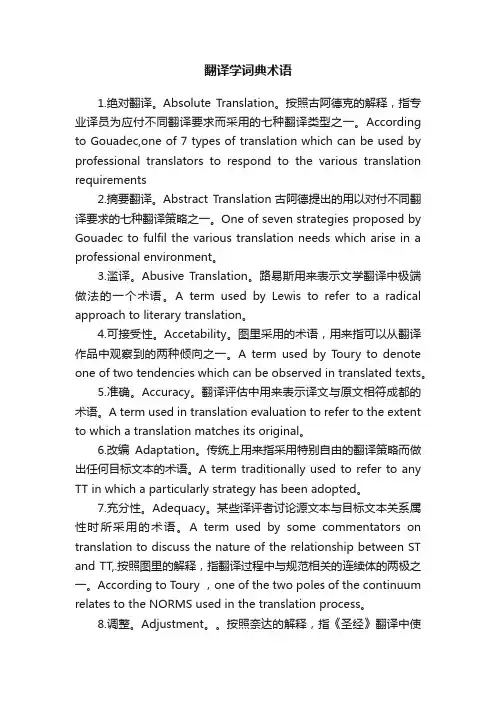
翻译学词典术语1.绝对翻译。
Absolute Translation。
按照古阿德克的解释,指专业译员为应付不同翻译要求而采用的七种翻译类型之一。
According to Gouadec,one of 7 types of translation which can be used by professional translators to respond to the various translation requirements2.摘要翻译。
Abstract Translation古阿德提出的用以对付不同翻译要求的七种翻译策略之一。
One of seven strategies proposed by Gouadec to fulfil the various translation needs which arise in a professional environment。
3.滥译。
Abusive Translation。
路易斯用来表示文学翻译中极端做法的一个术语。
A term used by Lewis to refer to a radical approach to literary translation。
4.可接受性。
Accetability。
图里采用的术语,用来指可以从翻译作品中观察到的两种倾向之一。
A term used by T oury to denote one of two tendencies which can be observed in translated texts。
5.准确。
Accuracy。
翻译评估中用来表示译文与原文相符成都的术语。
A term used in translation evaluation to refer to the extent to which a translation matches its original。
6.改编Adaptation。
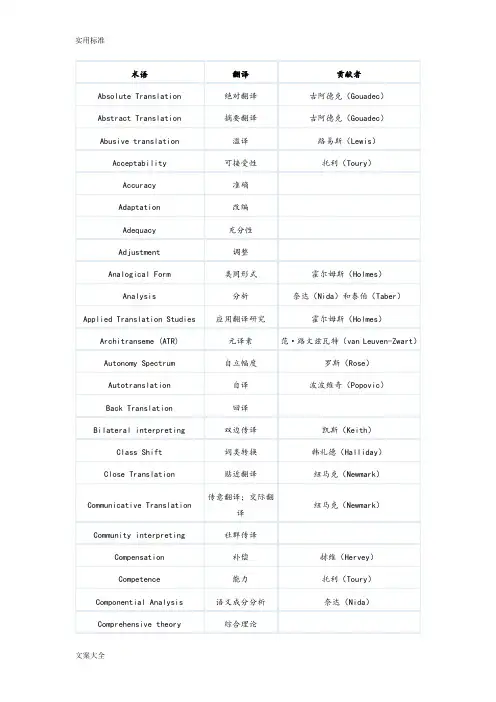
1.Source-oriented translation studies翻译研究趋势有两个维度,一个方面就是坚持面向原文本的程度,另一方面聚焦于语言和产生的译本。
以原文本为导向的是传统的规定性翻译研究的显著特征。
从原文本的视角分析翻译,把翻译视作语言文字间的转化,却忽视了文化语境。
书中有提到一个三角图,三角图的底线最左端代表原文本,最右端代表目标文本,左侧边代表原文本导向,右侧边代表目标文本导向。
最左端角过度强调原文本,以至很难区分翻译和直译的区别。
在现实中这种情况不常发生。
图中显示Catford 的形式对等,Nida的动态对等,Koller的语用对等,Beaugrande 基于文本的对等,以及Venuti的异化和对等都属于面向原文本的翻译研究。
2.Formal equivalenceCatford把翻译界定为“用目的语(TL)中对等的文本材料取代原语(SL)的文本材料,并把追求原语的等值成分视作翻译的中心问题,从而提出翻译理论的使命就是在于确定等值成分的本质和条件。
形式对应指任何译语范畴在译语的“机体”中尽可能占有与该原语范畴在原语中占有同等地位。
例如:用一个形容词翻译另一个形容词。
形式对应涉及原文本的语言形式,将原语中的结构形式原封不动地照搬入目的语,以原语为中心,最大限度显示原文中的形式与内容。
3.Translation shifts当无法遵守原文本的语言形式进行翻译操作时,文本对应通过Catford所述的翻译转换所形成。
当这两者概念发生分歧时,翻译转换尤其重要,其指从原语到译语的过程中偏离形式对应。
设计两种主要的转换:层次转化和范畴转换。
在层次转换中,位于一个语言层次的原语文本在译语的另一个层次中找到翻译对等。
翻译中唯一的层次转换是语法-词汇转换。
例如,原文本的文字游戏可能是通过利用目标语词汇层面进行翻译从而在语音层面得以实现,。
范畴转换是通用术语,指翻译偏离形式对等。
其分为四类:结构,类别,系统,单元转换。
学翻译必备的20个专业术语空中传译 2019-09-19 17:57:451. 归化:归化(法)是1995年由美国翻译理论家劳伦斯·韦努蒂在《译者的隐形》⼀书中提出的,是对意译概念的延伸,突破了语⾔因素的局限,扩展到语⾔、⽂化和美学等因素。
/归化法就是采取民族中⼼主义的态度,使外语⽂本符合译⼊语的⽂化价值观,把原作者带⼊译⼊语⽂化。
严复、林纾等都是“归化派”的代表,以其但后来由于“归化理论”的统治,某种意义上来说,导致了“⽂化帝国主义”的倾向。
/我们应该以异化为主,归化为辅,充分反应原作的⽂化特征,传递原语⽂化。
2. 异化:异化(法)是1995年由美国翻译理论家劳伦斯·韦努蒂在《译者的隐形》⼀书中提出的,是对直译概念的延伸,突破了语⾔因素的局限,扩展到语⾔、⽂化和美学等因素。
异化法就是接受外语⽂本的语⾔和⽂化差异,把读者带⼊外国情景。
/鲁迅是“异化派”的代表,但由于译作过分拘泥于原作,未得到⼴泛认可。
长期以来,由于“归化理论”对原语⽂化的损害,改⾰开放后,异化法在翻译界开始越来越得到重视,此法有助于充分反映原语⽂化特征,充分表达原⽂意义。
/但是,异化亦⾮万能,运⽤异化法我们既不能超越语⾔⽂化的规范限度,也不能超越读者的接受限度。
3. 语际翻译指不同语⾔之间的翻译活动,如将汉语⽂本译为外语⽂本,或将外语⽂本译为汉语⽂本。
/在中国,始于东汉末年终于北宋末年⽽盛于唐代的佛经翻译活动,可以说对中国⽂化的每⼀个层⾯都产⽣过深刻的影响。
同样,明末清初的科技翻译对清末⼒求⾃强⾰新的知识分⼦起到了巨⼤的启蒙作⽤。
语际翻译活动还直接影响到了中国现代性的形成,近代的⼀些思想家都是以语际翻译为利器,改造社会、⽂学以及语⾔的。
/我认为,语际翻译体现的是⼀种跨⽂化意义传递,是不同语⾔背景的⼈类进⾏思想交流的桥梁。
4. 语内翻译指同⼀语⾔的各个语⾔变体之间的翻译,如将⽅⾔译成民族共同语,将古代语译成现代语,把将歌译成散⽂等。
翻译专业术语大全本文为翻译专业术语大全,介绍翻译领域中常见的术语及其解释。
一、翻译1. Translation 翻译:将一种语言的文本用另一种语言表达的过程。
2. Translator/Interpreter 翻译员:从一种语言转换为另一种语言的专业人士。
3. Source Language(SL)源语言:被翻译文本的语言。
4. Target Language(TL)目标语言:翻译后的目标语言。
5. Bilingual 双语的:能听说读写两种语言的人。
6. Multilingual 多种语言的:能听说读写多种语言的人。
7. Translate 翻译:将源语言文本转换成目标语言文本。
8. Interpretation 口译:将源语言口述转换成目标语言口述。
9. Localization 本地化:将一个产品从一种语言转换成另一种语言,并符合该地区的文化、政治、习俗等环境。
二、文本类型1. Technical Text 技术文本:对某种科技、专业领域的知识、技能、思想等进行描述的文本。
2. Legal Text 法律文本:含法律内容的文本,如合同、法规等。
3. Medical Text 医学文本:含医学内容的文本,如医学论文、病历等。
4. Financial Text 金融文本:含金融内容的文本,如财经新闻、报告等。
5. Literary Text 文学文本:小说、诗歌等文学作品。
6. Commercial Text 商业文本:广告、宣传资料等商业性文本。
三、翻译术语1. Translation Theory 翻译理论:研究翻译规律、方法和技巧的学科。
2. Translation Studies 翻译研究:研究翻译现象、理论和实践问题的学科。
3. Translation Criticism 翻译批评:通过对原著和译文进行分析、比较和评价来评判翻译质量的学科。
4. Translation Equivalence 翻译等值性:翻译过程中,源语言和目标语言表达方式和意义上的相当性。
翻译专业术语汇总翻译专业术语汇总bsolute Trnsltion 绝对翻译bstrct Trnsltiondpttion 改编dequcy 充分[性]djustment 调整esthetic-Poetic Trnsltion 美学诗体翻译gent 经纪人. I. I. C 国际会议口译联合会nlogicl Form 类同形式nlysis 分析ppel-focused Texts 感染型问题本pplied Trnsltion Studies 应用翻译研究rchism/rchicism 古词;废词rchitrnseme (TR) 元译素re-restricted Theories of Trnsltion 关于范围的翻译理论udio-medil Texts 听觉媒介型文本uftrg 托付utomtic Trnsltion 自动翻译utonomy Spectrum 自立幅度utotrnsltion/Self Trnsltion 自译Bbel, Tower of XX别塔Bck-trnsformtion 逆转换Bck Trnsltion 回译Bilterl interpreting 双边传译Bilingul Corporl 双语语料库Bi-text 双文本Blnk Spces 空位Blnk Verse Trnsltion 无韵体翻译Borrowing 借用Clque/Lon Trnsltion 仿造CT (Computer-ided Trnsltion/ Computer-ssisted Trnsltion) 计算机辅助翻译Ctegory Shift 范畴转换Chuchotge 耳语传译Clss Shift 词类转换Close Trnsltion 贴近翻译Coherence 连贯Commission 托付Communiction Lod 传意负荷(又名Informtion Lod 信息负荷)Communictive Trnsltion 传意翻译;交际翻译(又名Communictive pproch [传意途径;交际途径])Community interpreting 社群传译(又名DilogueInterpreting [对话传译] 、Public Service Interpreting [公共服务传译])Commuttion 对换Compenstion 补偿Competence 能力Componentil nlysis成分分析Computer-ided Trnsltion 计算机辅助翻译(又名Computer-ssisted Trnsltion;简称CT)Concordnce 一致性Comprehensive Theory 综合理论Conference Interpreting 会议传译Consecutive interpreting 接续传译Constitutive Trnsltionl Conventions 建构性翻译常规Content-derivtive Form 派生内容的形式(又名Orgnic Form [有机形式])Content-focused Texts 重内容文本Contextul consistency 语境一致Controlled Lnguge 受控语言Conventions 常规Corpor 语料[库](单数为Corpus)Correspondence 对应Correspondences, Hierrchy of 对应层级Court Interpreting 法庭传译Covert Trnsltion 隐型翻译Cross-temporl Theories of Trnsltion 跨时翻译理论Cross-temporl Trnsltion 跨时翻译Cretive Trnsposition 制造性转换Cretive Treson 制造性叛逆Culturl pproch 文化途径Culturl Trnsltion 文化翻译Culturl Trnsplnttion 文化移植Culturl Trnsposition 文化置换。
术语翻译奉献者Absolute Translation绝对翻译古阿德克〔Gouadec〕Abstract Translation摘要翻译古阿德克〔Gouadec〕Abusive translation滥译路易斯〔Lewis〕Acceptability可承受性托利〔Toury〕Accuracy准确Adaptation改编Adequacy充分性Adjustment调整Analogical Form类同形式霍尔姆斯〔Holmes〕Analysis分析奈达〔Nida〕和泰伯〔Taber〕Applied Translation Studies应用翻译研究霍尔姆斯〔Holmes〕Architranseme (ATR)元译素·路文兹瓦特〔van Leuven-Zwart〕Autonomy Spectrum自立幅度罗斯〔Rose〕Autotranslation自译波波维奇〔Popovic〕Back Translation回译Bilateral interpreting双边传译凯斯〔Keith〕Class Shift词类转换韩礼德〔Halliday〕Close Translation贴近翻译纽马克〔Newmark〕Communicative Translation传意翻译;交际翻译纽马克〔Newmark〕Community interpreting社群传译Compensation补偿赫维〔Hervey〕Competence能力托利〔Toury〕Componential Analysis语义成分分析奈达〔Nida〕Comprehensive theory综合理论Conference interpreting会议传译Consecutive interpreting接续传译Contextual consistency语境一致奈达〔Nida〕和泰伯〔Taber〕Conventions常规诺德〔Nord〕Corpora语料库Correspondence对应Court interpreting法庭传译Covert translation隐型翻译豪斯〔House〕Creative transposition创造性转换Creative treason创造性叛逆罗伯特·埃斯卡皮〔Robert Escarpi〕Deconstruction解构主义德里达〔Derrida〕Descriptive translation studies描写性翻译研究霍尔姆斯〔Holmes〕Differance分延德里达〔Derrida〕Doentary translation文献型翻译诺德〔Nord〕Domesticating translation归化翻译韦努狄〔Venuti〕Dynamic equivalence动态对等奈达〔Nida〕Dynamic fidelity动态忠信比克曼〔Beekman〕和卡洛〔Callow〕Effort models用功模式贾尔〔Gile〕Equivalence对等Excluded receiver非目标承受者皮姆〔Pym〕Exegetic translation诠释性翻译赫维〔Hervey〕和希金斯〔Higgins〕Exoticism异国情调赫维〔Hervey〕和希金斯〔Higgins〕Expectancy norms期待标准切斯特曼〔Chesterman〕Explicitation明示维纳〔Vinay〕和达尔贝勒纳〔Darbelnet〕Expressive text表情型文本赖斯〔Reiss〕Extraneous form外来形式霍尔姆斯〔Holmes〕Faithfulness忠实Foreignizing translation异化翻译韦努狄〔Venuti〕Formal corresponding形式对应卡特福德〔Catford〕Formal equivalence形式对等奈达〔Nida〕Free translation自由译Full translation全文翻译General theories of translation普通翻译理论霍尔姆斯〔Holmes〕Gist translation要旨翻译赫维〔Hervey〕和希金斯〔Higgins〕Gloss translation释词翻译奈达〔Nida〕Grammatical transposition语法置换赫维〔Hervey〕和希金斯〔Higgins〕Hermeneutic motion诠释步骤斯坦纳〔Steiner〕Hierarchy of Correspondences对应层级霍尔姆斯〔Holmes〕Horizontal translation横向翻译福勒纳〔Folena〕Hyperinformation超额信息赖斯〔Reiss〕和弗米尔〔Vermeer〕Idiomatic translation地道翻译比克曼〔Beekman〕和卡洛〔Callow〕Imitation拟译德莱顿〔Dryden〕、利弗威尔〔Lefevere〕Indeterminacy不确定性Information offer信息提供弗米尔〔Vermeer〕Informative texts信息文本赖斯〔Reiss〕Initial norms初始标准托利〔Toury〕Instrumental translation工具翻译诺德〔Nord〕Integral translation整合翻译·路文兹瓦特〔van Leuven-Zwart〕Interlineal translation隔行翻译赫维〔Hervey〕和希金斯〔Higgins〕Interlinear translation逐行翻译Interlingual translation语际翻译雅可布逊〔Jacobson〕Intersemiotic translation符际翻译雅可布逊〔Jacobson〕Intralingual translation语内翻译雅可布逊〔Jacobson〕Intra-system shift系统内转换卡特福德〔Catford〕Inverse translation逆向翻译Kernel sentence核心句Keyword translation关键词翻译古阿德克〔Gouadec〕Level shift层次转换卡特福德〔Catford〕Lexical translation词汇翻译卡特福德〔Catford〕Liaison interpreting联络传译凯斯〔Keith〕Linguistic translation语言翻译Literal translation字面翻译;直译Mapping图谱霍尔姆斯〔Holmes〕Matricial norms矩阵标准托利〔Toury〕Meta-language元语言霍尔姆斯〔Holmes〕Metatext元文本Mimetic form模仿形式霍尔姆斯〔Holmes〕Mutation变异·路文兹瓦特〔van Leuven-Zwart〕Naturalness自然性Negative shift负面转换Norms标准Obligatory equivalents必要对等语奈达〔Nida〕Oblique translation曲径翻译维纳〔Vinay〕和达尔贝勒纳〔Darbelnet〕Operational model操作模式巴斯盖特〔Bathgate〕Operational norms操作标准托利〔Toury〕Optional equivalents可换对等语奈达〔Nida〕Overlapping translation重合翻译赫维〔Hervey〕和希金斯〔Higgins〕Overt translation显型翻译豪斯〔House〕Overtranslation超额翻译维纳〔Vinay〕和达尔贝勒纳〔Darbelnet〕Paradigmatic equivalence范式对等波波维奇〔Popovic〕Paraphrase释译德莱顿〔Dryden〕Partial theories of translation局部翻译理论霍尔姆斯〔Holmes〕Participative receiver参与型承受者皮姆〔Pym〕Particularizing translation具体化翻译赫维〔Hervey〕和希金斯〔Higgins〕Performance运用托利〔Toury〕Phonemic translation音素翻译利弗威尔〔Lefevere〕Phonological translation音位翻译卡特福德〔Catford〕Pivot language中枢语言Polysystem theory多元文化理论埃文·佐哈尔〔Even-Zohar〕Pragmatic Approach语用途径Pragmatic translation语用翻译Preliminary norms预先标准托利〔Toury〕Prescriptive translation studies规定翻译研究托利〔Toury〕Primary translation首级翻译迪勒〔Diller〕和康纳留斯〔Kornelius〕Problem-restricted theories oftranslation 关于问题的翻译理论霍尔姆斯〔Holmes〕Process-oriented translation theories过程取向翻译研究霍尔姆斯〔Holmes〕Product-oriented translation studies成品取向翻译研究霍尔姆斯〔Holmes〕Professional norms翻译标准切斯特曼〔Chesterman〕Prospective translation前瞻式翻译波斯特盖特〔Postgate〕Prototext原型文本波波维奇〔Popovic〕Pseudotranslation伪翻译Pure language纯语言沃尔特·本雅明〔Walter Benjamin〕Radical translation原始翻译奎因〔Quine〕Rank-bound translation级阶受限翻译卡特福德〔Catford〕Realia独有特征弗拉科夫〔Vlakhov〕和弗罗林〔Florin〕Receptor language承受语奈达〔Nida〕和泰伯〔Taber〕Translation with reconstruction重构式翻译古阿德克〔Gouadec〕Redundancy冗余奈达〔Nida〕Refraction折射利弗威尔〔Lefevere〕Regulative translational conventions规约性翻译常规诺德〔Nord〕Relay interpreting转接传译Repertoreme知识库要素托利〔Toury〕Resistancy阻抗韦努狄〔Venuti〕Restricted translation受限翻译卡特福德〔Catford〕Restructuring重组奈达〔Nida〕和泰伯〔Taber〕Retrospective translation后瞻式翻译波斯特盖特〔Postgate〕Rewriting重写利弗威尔〔Lefevere〕Rhymed translation韵体翻译利弗威尔〔Lefevere〕Secondary translation二级翻译迪勒〔Diller〕和康纳留斯〔Kornelius〕Selective translation选译古阿德克〔Gouadec〕Semantic disambiguation语义消歧Semantic translation语义翻译纽马克〔Newmark〕Serial translation序列翻译卡塞格兰德〔Casagrande〕Service translation效劳型翻译纽马克〔Newmark〕Sight translation视译Signed language translation手语传译Simultaneous interpreting同声传译Skopos theory目的论赖斯〔Reiss〕和弗米尔〔Vermeer〕Source language源语Source text源文本Source text-oriented translationstudies 源文本取向翻译研究Specification具体化Structure shift构造转换卡特福德〔Catford〕Stylistic equivalence文体对等Target language目标语Term banks术语库Terminology术语Text typology文本类型学Textual equivalence文本对等卡特福德〔Catford〕Textual norms文本标准托利〔Toury〕Thick translation增量翻译阿皮尔〔Appiah〕Think-aloud translation有声思维记录Third code第三语码弗劳利〔Frawley〕Time-restricted theories of translation 关于时域的翻译理论霍尔姆斯〔Holmes〕Total translation完全翻译卡特福德〔Catford〕Transcription注音Transeme译素·路文兹瓦特〔van Leuven-Zwart〕Transfer转移Transference迁移卡特福德〔Catford〕Translatability可译性Translationese翻译体Translatorial action译者行为赫尔兹·曼塔里〔Justa Holz-Manttari〕Transliteration音译Transposition置换维纳〔Vinay〕和达尔贝勒纳〔Darbelnet〕Unbounded translation不受限翻译卡特福德〔Catford〕Undertranslation欠额翻译纽马克〔Newmark〕Unit of translation翻译单位Universals of translation翻译普遍特征Verbal consistency词语一致Verifiability可核实性赖斯〔Reiss〕和弗米尔〔Vermeer〕Vertical translation纵向翻译福勒纳Voids空缺Whispered interpreting耳语传译Writer-oriented machine translation作者取向机器翻译。
翻译理论】翻译学术语列表本帖最后由 jeremy 于 2010-5-3 16:27 编辑在神圣的文本中,意义不再是流动的语言和流动的启明的分水岭。
当一个文本的直接的、不需要转达的含义成为其真正语言的、真理的或者理论的字面的有机部分,那它就具备了无条件的可译性。
此时,将不再是看在含义的份上,而仅仅是看在语言的份上而翻译。
与此相应,对翻译也提出了无限忠实的要求,也即必须和谐一样。
因为在某个高度上,一切伟大的作品,不过最高等的则是神圣的文本,其字里行间已经存在着其虚拟的译文。
的范本或理想本雅明思想的根源德国早期浪漫主义(1)德国早期浪漫主义的内省论对本雅明的翻译观几乎起着指引作用。
“内省”就是本雅明所谓的contemplation(观照),着重于对“思考的形式”进行思考(内在思考)。
(2)早期浪漫主义者费希特的知性强调直观性的内省判断力,即“绝对自我”对客体意向的判断。
(刘宓庆,2005:411- 412)本雅明的翻译观中也正体现了知性直观论的对其的影响。
(3)早期浪漫主义者倡导“内在批评”。
内在批评把作品看做是没有完成的,但作品本身包含着独特的自我展开的动力。
本雅明的语言观本雅明的语言观是一种在一定程度上带有神秘色彩的元语言观,即把语言看¡°创造¡±呈现出来的。
作为最高的造物主,上帝的创世是一种明确的语言表述。
(本雅明,1999:4)在本雅明看来,包括诗歌在内的一切艺术的语言处于一个较低的层次上,其语言不够纯净,不够完满,有许多东西是不可表达的,而这种不可表达性来自语言的物性。
本雅明的翻译观1)欣赏艺术作品或艺术形式的时候,考虑受众的因素从未给人带来任何好处。
谈论某一类的受众或他们代言人只会使人误入歧途。
而且,从理论上探讨艺术,甚至连“理想的”受众这个概念都会十分有害,因其无非设定了具有这类资格的人本身的存在和本性。
2)翻译若要发挥传递的功能,那么,除了信息之外,文学作品的本质不就是那些深奥难测、神秘难解、充满“诗意”的成分而且只有在译者本人也是诗人的情况下才能将其再现出来吗即使是很差劲的译者也会承认这一点。
术语翻译贡献者
Absolute Translation 绝对翻译
古阿德克( Gouadec)
Abstract Translation 摘要翻译
古阿德克( Gouadec)
Abusive translation 滥译
路易斯( Lewis )
Acceptability 可接受性
托利( Toury )
Accuracy
准确Adaptation
改编Adequacy
充分性Adjustment
调整
Analogical Form 类同形式
霍尔姆斯( Holmes)
Analysis 分析
奈达( Nida )和泰伯( Taber )
Applied Translation Studies 应用翻译研究霍尔姆斯( Holmes)
Architranseme (ATR) 元译素范·路文兹瓦特( van Leuven-
Zwart )
Autonomy Spectrum 自立幅度罗斯( Rose)
Autotranslation 自译
波波维奇( Popovic )
Back Translation 回译
Bilateral interpreting 双边传译凯斯( Keith )Class Shift 词类转换韩礼德( Halliday )Close Translation 贴近翻译纽马克( Newmark)
Communicative Translation 传意翻译;交际翻
译纽马克( Newmark)
Community interpreting 社群传译
Compensation 补偿赫维( Hervey )Competence 能力托利( Toury )Componential Analysis 语义成分分析奈达( Nida )Comprehensive theory 综合理论
( Darbelnet )
Expressive text 表情型文本
赖斯( Reiss )
Extraneous form 外来形式
霍尔姆斯( Holmes)
Faithfulness
忠实
Foreignizing translation 异化翻译
韦努狄( Venuti )
Formal corresponding 形式对应
卡特福德( Catford )
Formal equivalence 形式对等
奈达( Nida )
Free translation
自由译
Full translation
全文翻译
General theories of
translation
普通翻译理论霍尔姆斯( Holmes)
Gist translation 要旨翻译赫维( Hervey )和希金斯( Higgins )
Gloss translation 释词翻译奈达( Nida )
Grammatical transposition 语法置换赫维( Hervey )和希金斯( Higgins )
Hermeneutic motion 诠释步骤斯坦纳( Steiner )Hierarchy of Correspondences 对应层级霍尔姆斯( Holmes)Horizontal translation 横向翻译福勒纳( Folena )
Hyperinformation 超额信息赖斯( Reiss )和弗米尔( Vermeer )
Idiomatic translation 地道翻译比克曼( Beekman)和卡洛
( Callow )
Imitation 拟译德莱顿( Dryden )、利弗威尔
( Lefevere )
Indeterminacy 不确定性
Information offer 信息提供弗米尔( Vermeer )Informative texts 信息文本赖斯( Reiss )
Initial norms 初始规范托利( Toury )Instrumental translation 工具翻译诺德( Nord )
( Darbelnet )
Operational model 操作模式
巴斯盖特( Bathgate )
Operational norms 操作规范
托利( Toury )
Optional equivalents 可换对等语
奈达( Nida )
Overlapping translation 重合翻译
赫维( Hervey )和希金斯
( Higgins )
Overt translation 显型翻译
豪斯( House)
Overtranslation 超额翻译维纳( Vinay )和达尔贝勒纳
( Darbelnet )
Paradigmatic equivalence 范式对等
波波维奇( Popovic )
Paraphrase 释译
德莱顿( Dryden )
Partial theories of
translation
局部翻译理论霍尔姆斯( Holmes)Participative receiver 参与型接受者皮姆( Pym)
Particularizing translation 具体化翻译赫维( Hervey )和希金斯( Higgins )
Performance 运用托利( Toury )Phonemic translation 音素翻译利弗威尔( Lefevere )Phonological translation 音位翻译卡特福德( Catford )Pivot language 中枢语言
Polysystem theory 多元文化理论埃文·佐哈尔( Even-Zohar )Pragmatic Approach 语用途径
Pragmatic translation 语用翻译
Preliminary norms 预先规范托利( Toury )
Prescriptive translation
studies 规定翻译研究
托利( Toury )
Primary translation 首级翻译迪勒( Diller )和康纳留斯
( Kornelius )
Problem-restricted theories of 关于问题的翻译理霍尔姆斯( Holmes)
translation
论
Process-oriented translation
theories
过程取向翻译研究霍尔姆斯( Holmes)
Product-oriented translation
studies
成品取向翻译研究霍尔姆斯( Holmes)
Professional norms 翻译规范
切斯特曼( Chesterman )
Prospective translation 前瞻式翻译
波斯特盖特( Postgate )
Prototext 原型文本
波波维奇( Popovic )
Pseudotranslation
伪翻译
Pure language 纯语言
沃尔特·本雅明( Walter
Benjamin )
Radical translation 原始翻译
奎因( Quine )
Rank-bound translation 级阶受限翻译
卡特福德( Catford )
Realia 独有特征弗拉科夫( Vlakhov )和弗罗林
( Florin )
Receptor language 接受语
奈达( Nida )和泰伯( Taber )
Translation with
reconstruction
重构式翻译古阿德克( Gouadec)Redundancy 冗余奈达( Nida )
Refraction 折射利弗威尔( Lefevere )Regulative translational
conventions
规约性翻译常规诺德( Nord )Relay interpreting 转接传译
Repertoreme 知识库要素托利( Toury )
Resistancy 阻抗韦努狄( Venuti )Restricted translation 受限翻译卡特福德( Catford )Restructuring 重组奈达( Nida )和泰伯( Taber )Retrospective translation 后瞻式翻译波斯特盖特( Postgate )。